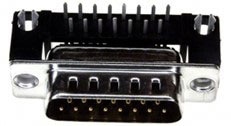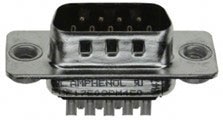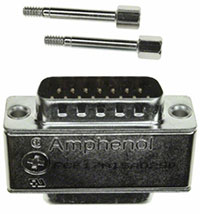Readily Suppress EMI with Filtered D-Sub Connectors
D-Sub connectors are essential components in a wide range of applications spanning industries where they provide reliable, durable, and versatile interconnects for signal and power transmission. But they also can play a vital role in electromagnetic compatibility (EMC) compliance.
Modern electronic systems rely on high-speed data transmission and precise control signals, but electromagnetic noise from nearby devices, power lines, or radio frequencies can degrade performance.
Poor electromagnetic interference (EMI) management can result in data errors and system instability. It can lead to failed EMC compliance tests that result in delayed product launches and increased costs. Filtered D-Sub connectors can help ensure applications operate correctly without being impacted by or causing EMI in applications where crosstalk, impedance mismatches, and noise can disrupt high-speed signals. They are used in modern applications for automotive, renewable energy, smart meters, handheld devices, and AI systems.
Filtered D-Sub connectors integrate EMI filtering components such as capacitors and ferrite beads directly into the connector shell, reducing circuit board complexity and component count, making them a space-saving and cost-effective option.
While many vendors offer high-quality connectors, the specific design and construction may vary. For example, Amphenol Communications Solutions offers a range of D-Sub filter connectors with a mechanically stress-isolated design to ensure that capacitive elements survive shock and vibration.
The company's FCE17 Series feature enhanced EMC compliance and immunity, shunting to ground the radiated and conducted emissions from a device, as well as external EMI and radio frequency interference (RFI). They integrate ceramic capacitor filter elements that are protected from shock and vibration by a solderless internal design, providing excellent stability amidst temperature and voltage changes.
The filtered connectors fit standard non-filtered connector footprints, which makes for a drop-in replacement to existing applications. This provides an easy, cost-effective way to improve EMC without extensive design changes.
Amphenol provides a wide range of FCE17 connectors with configurations to suit different design needs. Product developers can choose from connectors with standard pin and socket arrangements of 9, 15, 25, and 37, termination types of PCB tail or solder cup, and integration of both power and signal contact combinations within a single connector body.
Here are three of Amphenol's connectors that illustrate features and application suitability:
- The FCE17-A15PA-450 (Figure 1) is a right-angle, PCB-mount, 15-position D-Sub connector that supports low-profile installation in compact board applications such as industrial controllers, test equipment, and embedded computing systems. It features through-hole solder terminations for a strong and reliable connection to a PCB. Board locks and grounding indents enhance mechanical stability and electrical shielding.
 Figure 1: The right-angle FCE17-A15PA-450 D-Sub filter connector provides a low-profile design option. (Image source: Amphenol Communications Solutions)
Figure 1: The right-angle FCE17-A15PA-450 D-Sub filter connector provides a low-profile design option. (Image source: Amphenol Communications Solutions)
- The FCE17-E09PM-450 (Figure 2) is a 9-position, in-line male plug with solder cup termination for custom cable assemblies. Designers can utilize this to tailor connections for unique system requirements, such as data transmission in industrial automation, telecommunications, and defense applications.
- The FCE17-A15AD-250 (Figure 3) is an in-line adapter well-suited for upgrading legacy systems, allowing designers to add EMI suppression without altering existing PCB layouts or replacing connectors. The 15-position female-to-male D-Sub adapter is a cost-effective, time-saving option for legacy industrial control panels and other applications where a complete redesign is undesirable.
 Figure 2: Amphenol's FCE17-E09PM-450 D-Sub filter connector comes with a solder cup termination for custom cable designs. (Image source: Amphenol Communications Solutions)
Figure 2: Amphenol's FCE17-E09PM-450 D-Sub filter connector comes with a solder cup termination for custom cable designs. (Image source: Amphenol Communications Solutions)
 Figure 3: The FCE17-A15AD-250 in-line D-Sub adapter provides a cost-effective option for adding EMI suppression to existing designs. (Image source: Amphenol Communications Solutions)
Figure 3: The FCE17-A15AD-250 in-line D-Sub adapter provides a cost-effective option for adding EMI suppression to existing designs. (Image source: Amphenol Communications Solutions)
Conclusion
Filtered D-Sub connectors offer a versatile and effective solution for addressing EMI challenges in a broad range of applications. By integrating filtering elements into the connector shell, they simplify PCB design, reduce costs, and enhance the overall performance and reliability of electronic systems. With a range of configurations and termination types available, Amphenol's FCE17 Series makes it easy to find the right connector to achieve EMC compliance and system robustness.

Have questions or comments? Continue the conversation on TechForum, DigiKey's online community and technical resource.
Visit TechForum








